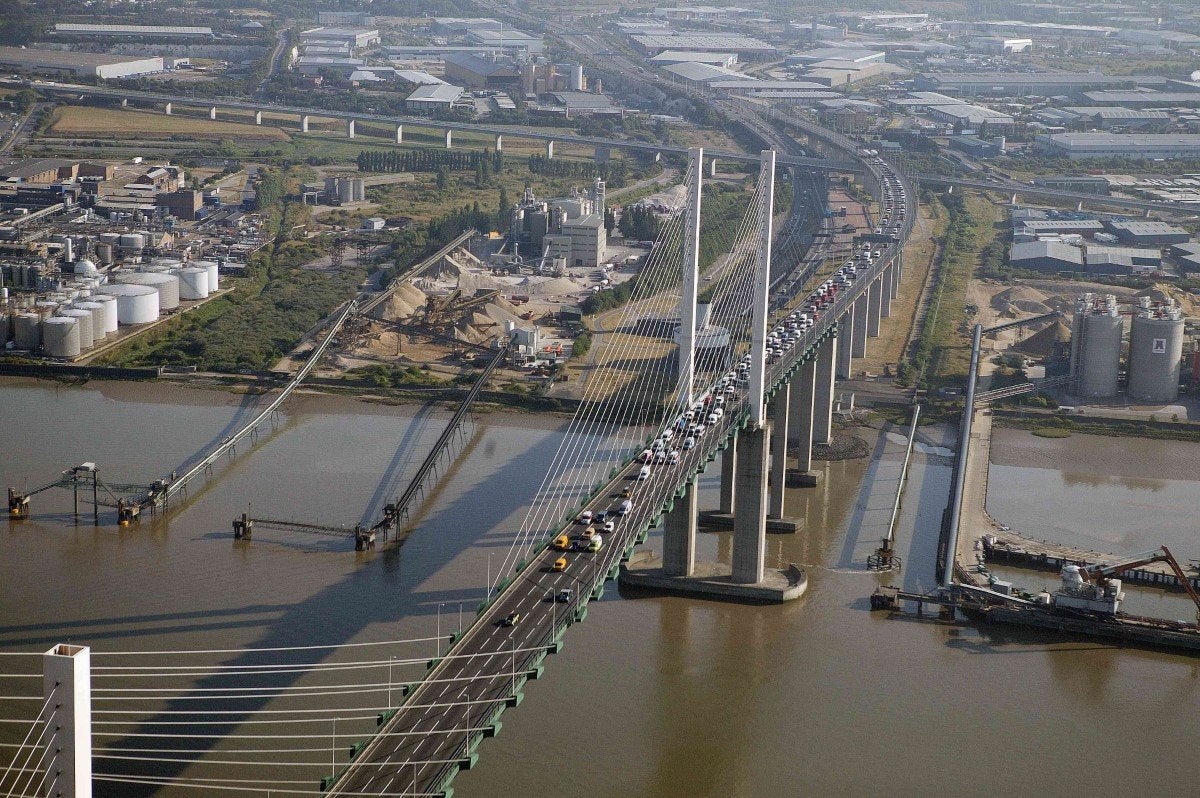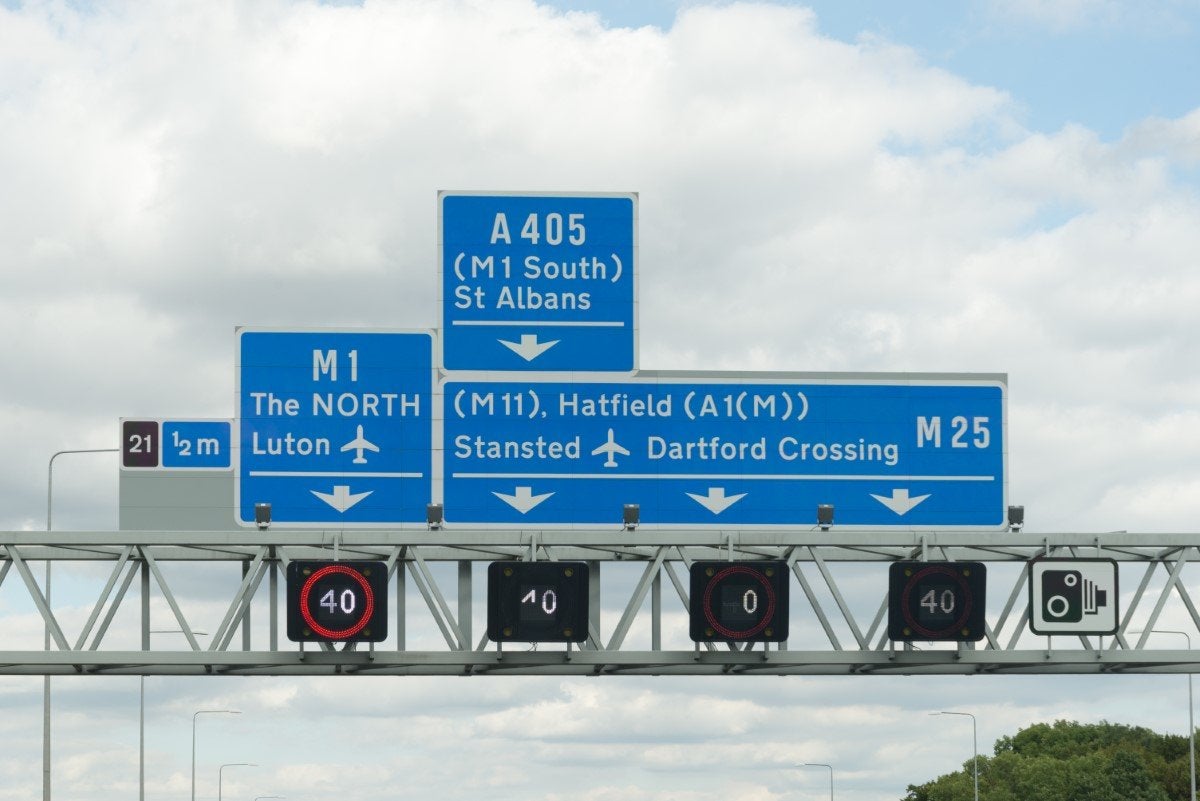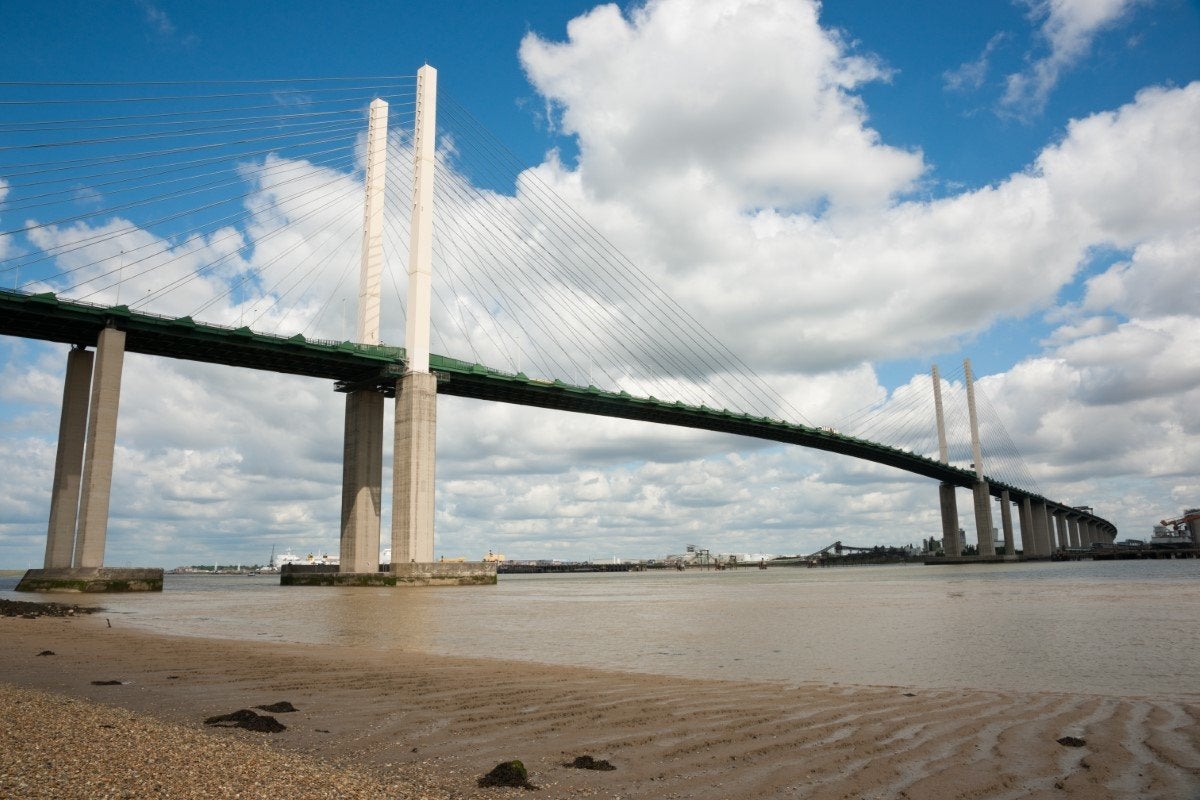The Dartford Crossing is the main route across the River Thames to the east of London – and one of the few river crossings in the UK that requires a toll to cross it. It’s crossed by more than 180,000 vehicles on its busiest days, and closes the loop of the M25 London Orbital motorway. The infrastructure combines a pair of two-lane tunnels heading northbound (known as the Dartford Tunnel), and a four-lane suspension bridge conducting traffic southbound. But just how does the Dartford Crossing (and its toll, known as the Dart Charge) work? And how much does it cost to cross? Our ultimate guide reveals all.
Dart Charge And The Dartford Crossing: Everything You Need to Know
- How Much is the Dart Charge?
- What Times Does the Dart Charge Apply?
- How to Pay the Dart Charge
- How Much is the Fine if You Forget to Pay?
- Are there any Dart Charge Discounts Available?
- What is a Dart Tag?
- Fascinating Facts About the Dartford Crossing
- A History of the Dartford Crossing
How Much is the Dart Charge?

The charge varies depending on what kind of vehicle you’re driving, and it’s also reduced if you open a Dart Charge account – more on which below.
The fee structure is fairly simple though. If you’ve got a car or a motorhome, or a minibus with nine seats or fewer, the charge is £2.50, or £2.00 with a pre-pay account. In a bus, coach or goods vehicle with two axles, you’ll pay £3.00, or £2.63 with an account. And in a bus, coach or goods vehicle with more than two axles, the cost goes up to £6.00, or £5.19 for account holders.
There is no payment required for motorcycles, mopeds or quad bikes.
What Times Does the Dart Charge Apply?
Charges apply between 6am and 10pm every day, and that includes weekends and bank holidays.
How to Pay the Dart Charge
The easiest way to pay is by credit or debit card, using the Government’s Dart Charge website at https://www.gov.uk/pay-dartford-crossing-charge. Enter your payment card details and the payment should be taken instantly.
However, there are other payment methods. If you’d prefer to pay cash, you can do so at your nearest Payzone store, which includes most post offices and some local newsagents.
You can also pay by post, using a cheque or postal order, or pay using a credit card over the phone, by calling Dart Charge Customer Services on 0300 300 0120. Lines are open daily between 8am and 8pm.
In addition, you can set up an account, with which you can register your car (or cars) with the Dart Charge system and pay automatically through pre-payment or by linking your Dart Charge customer account to a debit or credit card. You can do this online or over the phone, and you can top up your account by post, too.
How Much is the Fine if You Forget to Pay?
If you don’t pay the charge by midnight the following day, you’ll automatically be landed with a penalty charge notice (PCN) of £70, which is due within 28 days of being issued. If you don’t pay the fine within that time, it increases to £105, plus the crossing charge. By contrast, if you pay within 14 days, the fine is halved to £35.

Are there any Dart Charge Discounts Available?
Yes – local residents who live in either Dartford Borough or Thurrock councils are eligible for a discounted rate. They can choose either to pay £20 a year for unlimited usage of the Crossing, or to pay £10 for 50 crossings, plus 20p for each additional crossing.
Which option works out best? Well, if you’re local to the Crossing and you use it more than 100 times a year, it makes more sense to pay the one-off payment of £20 – otherwise, the £10 plus 20p option will work out cheaper.
Motorists who are eligible for free Vehicle Excise Duty (VED) as a result of a disability have an exemption from the Dart Charge.
What is a Dart Tag?
The Dart Tag was a payment system used when the Dartford Crossing used manned booths, instead of the camera-operated system it uses now to read and log your vehicle registration. Owners of a Dart Tag were able to sign up for an account and receive a windscreen-mounted tag.
The tag would be picked up by overhead sensors at the crossing, which would debit the owner’s account and raise the barrier. This meant they could drive through dedicated lanes to bypass the manned booths and thus save time.
Fascinating Facts About the Dartford Crossing

- The Crossing’s two tunnels are 1,430 metres long, which makes them almost the same length as the 1,410-metre Humber Bridge.
- The Queen Elizabeth II bridge is relatively short by comparison, at just 450 metres, but it actually had the longest span of any cable-stayed bridge in Europe when it opened in 1991.
- The bridge rises to 137 metres above the River Thames – taller than several of London’s skyscrapers, including Millbank Tower and Centre Point.
- Although it is contiguous with the M25, which itself circumnavigates central London, the Dartford Crossing isn’t actually a motorway. It’s officially designated as the A282, a trunk road. Highways England says it was planned this way so that vehicles that are prohibited from motorways, such as mopeds, can use it. The crossing sits between junction 31 and junction 1a of the M25.
- Pedestrians are not allowed to cross, but cyclists are – though they aren’t allowed to ride across themselves. Instead, they’re taken across by a specially converted van.
- The Dart Charge generated almost £209m of income in the financial year 2019-20. Almost £73m of this came from fines, while £343,000 came from fees charged to abnormal loads. The rest came from charges paid by road users.
- Part of the reason that the Dartford Crossing gets so busy is because it’s close to two of the UK’s largest retail outlet locations - the Bluewater and Lakeside shopping centres.
- The Dartford Crossing has a reputation for being one of the UK’s busiest national highways, with long queues often building up on this major road. This can often be exacerbated by essential maintenance works that need to be carried out on a fairly regular basis.
A History of the Dartford Crossing
The Dartford Crossing is in fact not one crossing, but three – and all three crossings came into being at different times.
The west tunnel came first. A Dartford-Thurrock river crossing was first proposed in 1924, and construction began in 1936, but was put on hold during the Second World War, and the tunnel didn’t open until 1960. A toll was levied by Kent and Essex councils, who were jointly responsible for the tunnel’s upkeep; the fee was two shillings and sixpence. With one lane in each direction, the original tunnel was designed to cope with two million cars a year, but by 1970 it was carrying eight million – the need to expand the crossing was clear.
The east tunnel was approved by 1971, and opened in 1980; the western tunnel was converted to handle northbound traffic, with the eastern for southbound traffic, both tunnels with two lanes apiece.
However, as completion of the M25 neared in the late 1980s, concerns grew that the new motorway would increase the strain on the tunnels yet again. Construction of a new bridge was approved in 1986, and in 1988, a Private Finance Initiative was enabled to fund its construction.
At this point, control of the Crossing transferred from Kent and Essex councils to a new company, Dartford River Crossing Limited, which would bear the debt of the bridge until it was paid off through tolls.
The new bridge was planned to be called simply the Dartford Bridge, until Essex residents objected, suggesting instead it be called the Tilbury Bridge. As a compromise, it was named after Queen Elizabeth II, who opened the bridge officially on 30 October 1991. As such, it’s known simply as The Queen Elizabeth II bridge, The QEII Bridge, The QE2 Bridge, or affectionately by some as ‘The Lizzy Brizzy’.

The next major change to the Crossing came on 30 March 2002, when it was deemed that the debt incurred in the bridge’s construction had been paid off. At this point, the toll could no longer be levied, but road user charging didn’t end there: on 1 April 2003, the toll was replaced with a congestion charge now known as the Dart Charge.
In 2012, the Government announced that the toll booths – a major source of congestion at the Crossing – would be removed in favour of a free-flow toll system, which would use automatic number plate recognition (ANPR) functionality to recognise cars’ registrations. Users would now have to pay in advance or immediately after using the Crossing. The scheme was up and running by November 2014, and the toll booths themselves were removed by April 2015. Highways England claimed that the move reduced peak-time round trips by 15 minutes.
But the biggest easement to the congestion for which the Crossing has become infamous is predicted to come with the opening of the Lower Thames Crossing, a new tunnel planned for construction to the east of the Dartford Crossing.
It’s hoped that by moving much of the traffic both from and destined for Kent and the Channel Ports from the Dartford Crossing, traffic congestion will reduce substantially. However, the new crossing is not expected to come along any time soon; construction was supposed to start in 2024, but that’s been delayed until 2026 at least, and the bridge is likely to take at least three years to build.
